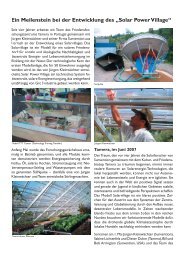Create successful ePaper yourself
Turn your PDF publications into a flip-book with our unique Google optimized e-Paper software.
GETTING TO KNOW THE BEING OF WATER<br />
The first step in the change of thinking begins with a new perception of water itself. A water<br />
retention space is not only to be understood technically but also exists in order to give an<br />
understanding of the being of water to a new kind of engineers. A water retention space has<br />
to be shaped in a way that the water does not stagnate, but on the contrary is able to move<br />
according to its being.<br />
Water is not only a physical or chemical substance that the human may deal with at his<br />
convenience or merely according to industrial norms. Water is a living being. We modern<br />
people have to learn to understand this all over again. The shaping of the water retention<br />
spaces is therefore not arbitrary. We observe water: How does it want to move? Which<br />
shapes of banks does it like? Which temperature and which differences in temperature does<br />
it like? Does it like to form waves or not? All of these aspects are incorporated into our work.<br />
As with every living being, water also needs to be allowed the freedom to move in<br />
accordance with its being. Water wants to roll, swirl, curve and meander – then it remains<br />
vital and fresh. By such movement it purifies itself, at the same time it also calms down and<br />
has time to seep into the earth-body.<br />
There are three important principles for the shaping of such water retention spaces:<br />
The longer side of the retention space is, if possible, laid out in the same direction as that of<br />
the prevailing wind. The wind then blows over a long surface thereby forming waves which<br />
oxygenate the water: oxygen is an important element for the purification of water. Wind and<br />
waves carry particles of debris to the shores where they are trapped by aquatic plants and<br />
eventually absorbed by them.<br />
Banks are never straightened or reinforced, but created in meandering forms with both steep<br />
and gently sloping parts so that the water can roll and swirl. At least one part of the shore is<br />
planted with aquatic and waterside plants.<br />
Deep and shallow zones are created. In this way different temperature zones emerge which<br />
provide healthy thermodynamics in the water. Shaded shore areas support this process.<br />
Thus the diversity of aquatic organisms finds its suitable habitats.<br />
The dam of a water retention space consists entirely of natural material: no artificial film<br />
or concrete is used. The vertical sealing layer of the dam consists of as fine a material as<br />
available – ideally clay – for which optimally the material excavated from the deep zones is<br />
used. It is connected to a watertight layer of subsoil that sometimes lies a few metres below<br />
the surface. The sealing layer is compacted and built-up layer by layer with fine, earth-moist<br />
material. Then it is piled up from both sides with mixed earth-material, covered with humus<br />
or topsoil, and can then be landscaped and planted on.<br />
Through this natural construction method the water retention spaces fit in with the<br />
landscape and do not become incongruous with their surroundings. After only a short time<br />
life reappears on the shores. Finally the plants, especially the trees, are once again provided<br />
with water from below as is appropriate to their nature. And we need rely less and less, and<br />
eventually not at all, upon artificial irrigation from above.<br />
THE HELPING FORCES<br />
In the construction of Water Retention Landscapes there is an abundance of helping<br />
forces from the kingdom of nature that stand by our side. Knowing this, the new engineers<br />
get in contact with these forces and ask them for their co-operation. There are millions<br />
©<br />
Copyleft: Institute for Global Peace Work (IGP)











